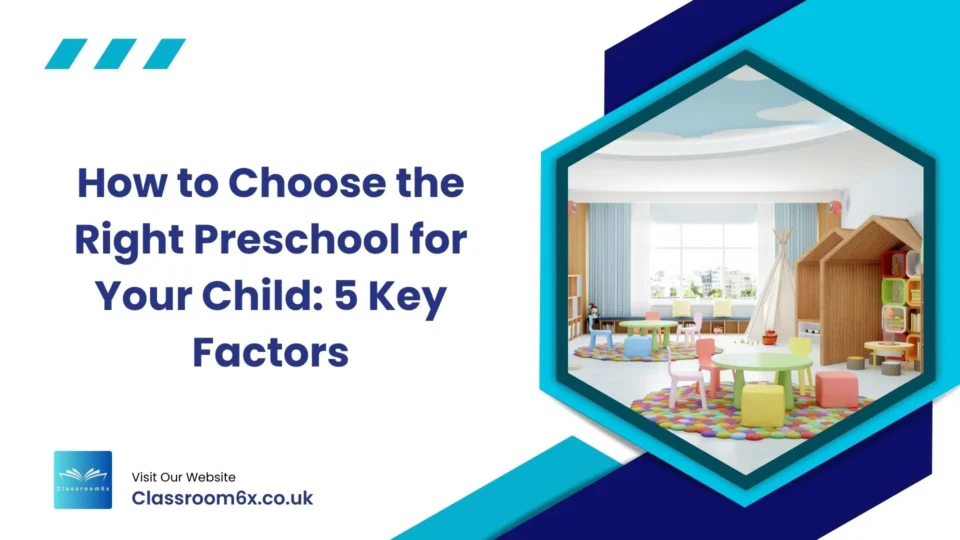How to Choose the Right Preschool for Your Child: 5 Key Factors

Choosing the right preschool for your child is a big decision. It’s where they’ll take their first steps into structured learning, develop social skills, and build a foundation for lifelong education. But with so many options out there—public, private, bilingual nurseries, and international kindergartens—how do you make the right choice? Let’s break it down into five key factors to consider.
1. Understanding Your Child’s Needs
Before diving into preschool options, take a moment to assess your child’s personality, interests, and learning style. Every child is unique, and the right preschool should cater to their individual needs.
Identifying Learning Styles and Preferences
Some children thrive in structured environments, while others prefer a more play-based approach. If your little one is curious and loves hands-on activities, an international nursery with interactive lessons might be a perfect fit.
Additionally, consider whether your child would benefit from a curriculum that includes multiple languages. Exposure to different languages at an early age can improve cognitive skills and problem-solving abilities.
Social and Emotional Readiness
Does your child enjoy group activities, or are they more reserved? A quality preschool should offer a nurturing environment where children can develop social skills at their own pace. Look for programs that encourage collaboration, communication, and self-expression.
Special Needs and Individualized Support
If your child has special learning needs, look for a preschool with experienced teachers and a strong support system. Look for schools which prioritize inclusivity and personalized attention to help every child flourish. They emphasize emotional intelligence, cultural awareness, and individualized learning plans.
2. Evaluating the Curriculum and Teaching Approach
Preschools offer a variety of educational philosophies, so it’s important to find one that aligns with your values and your child’s learning style.
Play-Based vs. Academic Learning
Some preschools focus on academics with early reading and math lessons, while others emphasize play-based learning to foster creativity. International nurseries often integrate both approaches, making learning fun and engaging. Play-based learning enhances creativity, critical thinking, and problem-solving skills, which are crucial for long-term academic success. Apple Tree International Kindergarten & Nursery with the website address https://appletree-kindergarten.hu focuses on experience-based learning, because little ones learn best by playing.
STEM, Language, and Arts Integration
A well-rounded curriculum should incorporate science, technology, engineering, and math (STEM), as well as language development and creative arts. If you’re considering an international kindergarten, check if they offer language immersion programs to support bilingualism. Early exposure to multiple languages enhances cognitive flexibility and memory retention.
Teacher-Student Interaction and Engagement
Observing a class in action can reveal a lot. Are the teachers patient and engaging? Do they encourage participation and critical thinking? A strong student-teacher bond fosters a positive learning experience. Apple Tree International Kindergarten & Nursery prioritizes small class sizes and a hands-on approach to teaching, ensuring each child gets the attention they need to thrive.
3. Assessing Safety, Location, and Facilities
Safety and convenience are non-negotiable when choosing a preschool. Here are a few essential aspects to evaluate.
School Safety Policies and Emergency Procedures
A reputable preschool should have clear safety protocols, including secure entry systems, well-trained staff, and emergency plans. Make sure the school has regular fire drills and a secure pick-up/drop-off process.
Classroom Environment and Cleanliness
A clean and organized classroom promotes healthy learning. Visit the preschool to check if the learning spaces are well-maintained and child-friendly. A clutter-free environment with bright, engaging materials can enhance focus and learning.
Distance and Convenience for Daily Commutes
While a top-rated international kindergarten might sound appealing, a long commute can be stressful for both you and your child. Choose a location that’s practical and accessible. Many parents prefer a preschool near their workplace or home to make drop-offs and pick-ups easier.
Outdoor and Play Facilities
Children need outdoor time for physical activity, exploration, and social interaction. Schools with well-maintained playgrounds and green spaces provide children with opportunities for active play and hands-on learning in nature.
4. Checking Teacher Qualifications and School Reputation
The quality of educators and the school’s reputation can make or break your child’s preschool experience.
Teacher Credentials and Experience
Look for preschools with qualified and experienced teachers who understand child development and use innovative teaching methods. Teachers at Apple Tree International Kindergarten & Nursery are trained in modern teaching methodologies, ensuring a supportive and engaging learning environment.
Parent Reviews and Word-of-Mouth Recommendations
Nothing beats firsthand experiences. Ask other parents about their experiences with the preschool and read online reviews. International nurseries and preschools with strong reputations often have glowing testimonials from families who have seen positive growth in their children.
Accreditation and Licensing Standards
Ensure that the preschool meets national or international education standards. Accredited international nurseries and kindergartens typically offer higher-quality programs. Accreditation indicates adherence to best practices in early childhood education.
5. Understanding Costs and Enrollment Process
Preschool fees vary widely, so it’s essential to find an option that fits your budget without compromising quality.
Tuition Fees and Additional Expenses
Beyond tuition, consider costs for uniforms, meals, field trips, and extracurricular activities. Some international preschools may have higher fees due to their specialized programs. Factor in these additional costs when making your decision.
Financial Aid and Scholarship Options
Some schools offer financial aid or discounts for siblings. Don’t hesitate to ask about available funding options. Investing in a high-quality preschool is a long-term benefit for your child’s education.
Application Deadlines and Admission Criteria
Popular preschools often have long waitlists. Start researching early and prepare the necessary documents for a smooth application process. A well-prepared application can increase your child’s chances of securing a spot.
Final Thoughts
Choosing the right preschool is about finding the best fit for your child’s growth, happiness, and future success. Whether you opt for an international nursery or preschool, prioritize a nurturing environment, a well-rounded curriculum, and dedicated teachers. If you’re looking for a top-tier option in Hungary, check out Apple Tree International Kindergarten & Nursery (https://appletree-kindergarten.hu), where learning is fun, engaging, and tailored to your child’s needs.
FAQs
1. What age should my child start preschool?
Most children start preschool between the ages of 2 and 4, depending on their readiness and the preschool’s admission criteria.
2. How do I know if a preschool is safe?
Check for secure entry points, background-checked staff, and clear emergency protocols. A safe preschool should also have a low student-to-teacher ratio, clean facilities, and positive reviews from other parents. Visiting in person can help you assess the environment and teacher interactions.
3. What is the difference between a bilingual nursery and an international kindergarten?
A bilingual nursery focuses on early language exposure in two languages, while an international kindergarten provides a broader multicultural curriculum with global education standards.
4. How important is accreditation when choosing a preschool?
Accreditation ensures the preschool meets quality education standards, so it’s a strong indicator of a reputable institution.
5. Can a preschool help with my child’s social development?
Absolutely! Preschools encourage interaction, teamwork, and emotional growth, helping children develop essential social skills.
6. How can I help my child transition smoothly into preschool?
To ease the transition, visit the preschool with your child beforehand, establish a consistent drop-off routine, and talk positively about the new experience. Encouraging independence at home, such as dressing themselves or following simple instructions, can also help build confidence.











